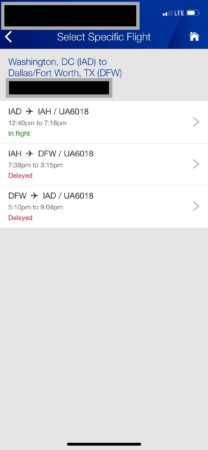Business Travel At Its Best: The Anatomy Of A Flight Delay

Business travel leaves plenty to be desired. If you make the best of it, and plan for delays, it’s a lot less frustrating. Delays happen for all kinds of reasons. I found the circumstances behind a recent delay interesting enough that I felt like writing about it.
I was scheduled to connect in Houston (IAH) on United in order to reach my destination. There were thunderstorms in the Dallas area but mostly clear in Houston. Afternoon thunderstorms are a daily occurrence in Dallas during the summer, less so in the colder months. When I landed at IAH I saw that my connecting flight was now showing a 40-minute delay. Normally I wouldn’t sweat a small delay. But, I had a meeting first thing in the morning and another flight out. So, timing was key. A cancellation would cause a bunch of issues for my schedule. Time to dig into it.
I grabbed a bit of dinner and took a conference call for work while I kept my eye on my flight. My inbound plane was coming from DFW. The reason for the delay was obvious, but the true length of the delay wasn’t. I started tracking the flight before that one. That’s a great feature of the United app.
If you check flight status, there’s this very useful option labeled “Where Is This Aircraft Coming From?” You can use this option to theoretically keep tracking your plane further and further back in its schedule. This is very helpful in a delay. The airlines are notoriously bad at showing realistic information in situations like this. Maybe they’re optimistic they can “catch up” from a delay over the course of a day. They can also swap planes around to catch up, to some degree.
In this situation, the inbound flight to DFW was delayed a few hours due to weather. Once it got to DFW, it needed to unload, reload and take off for IAH. I wasn’t optimistic. I kept checking the app every 5-10 mins to see if the flight had landed or diverted. Weather radar looked dicey at DFW.
The departure time for my flight kept getting later and later. Then, on the umpteenth time I checked the app, the flight bound for DFW was now bound for IAH. Sure looked like a diversion to me. Except the United 1K desk was still positive the plane was headed for Dallas. So were the folks at the United Club. Flight Aware and United’s own app disagreed with them.
I was starting to think I should consider an alternate flight. There was an alternate airport I could consider but no more flights to my preferred destination. How late should I wait before jumping ship on my original flight?
I was finally able to convince a very nice United Club agent to call someone in flight operations to get a better idea of what was going on. I was only able to hear her side of the conversation but it was promising: “So, Flight XXXX is coming here instead? And, you’re moving the people on that plane somewhere else? And, that plane is going on to XXXX?”
All good answers. You never know what can happen in a delay. I certainly wasn’t expecting them to essentially “skip” a flight and catch up on us. But, that meant we were back on schedule. A 90-minute delay dropped to a 10-minute one. Now, instead of a bunch of extra time in the club we were being told to start heading to the gate.
For those unfamiliar with IAH, the regional jets are housed in the B terminal. There are some old-fashioned “pods” where the jet bridges are all spokes that poke out from a round waiting area. The passengers headed to one gate in a B pod. At this point, we were 25 minutes from the newly announced departure time (about 10 minutes later than scheduled). There was a plane and a gate agent at our gate. Success!
Hold On A Minute
The plane at our gate started pushing back. Oopsie, that wasn’t our plane. The gate agent was answering questions while trying to type, seemingly getting set up for the departure of our flight. She finally stopped and picked up the microphone to answer the question on all of our minds. If that plane was pushing back, and we were scheduled to leave in 20 minutes, where was our plane?
She told us our plane was parked two gates over and that they were towing it two gates over to us. This was from gate B79 to B83. Literally less than 100 foot walk. Sure, because that makes the most sense.
After another 20 minutes or so (and another adjustment t0 our departure time) the gate agent finally announced that they would not be towing the plane and that we should all walk over to gate B79. 30 seconds later, we were all waiting to board. She opened the boarding door and radioed down…..to find out we were short two crew members. Two more adjustments to the departure time later and we were now back at the original delayed time when the plane was still going to DFW. Are you following all this?
15 minutes later our crew members showed up and we were finally boarding.
The Final Two Pennies
Delays don’t happen every day but they happen more often than you might expect. That’s especially the case if you don’t plan smartly. Booking an afternoon DFW flight in the summer time is asking for trouble. Similarly, Chicago in the winter is dicey.
Throughout this process, I never lost my cool. That’s a sure-fire way to not get what you wanted. Even when you’re right, many airline employees aren’t going to go out their way to help you. You need to stay on top of your itinerary.
The biggest downside to all of this is the time sink. When things go smoothly, flights are a normal part of business travel. I periodically check to make sure everything is on track but mostly focus on work. When there’s a delay, I need to stay on top of those details. The sacrifice is productivity, especially when the airline doesn’t give you accurate information (gate changes, crew missing).
It’s all part of a day on the road.
The post Business Travel At Its Best: The Anatomy Of A Flight Delay was published first on Pizza in Motion


